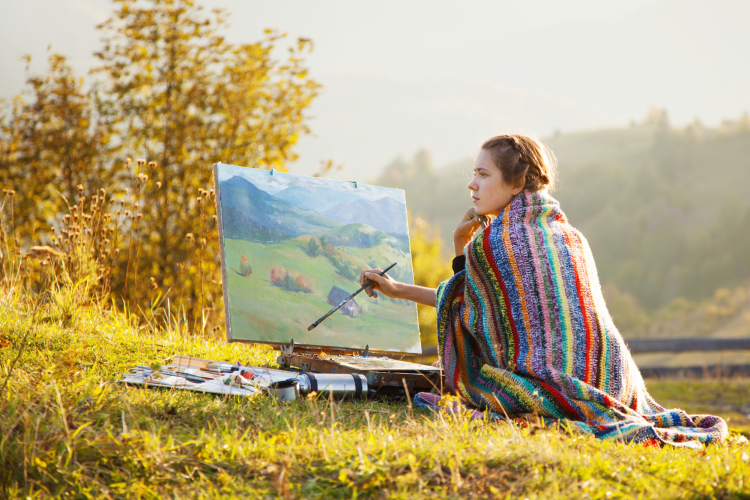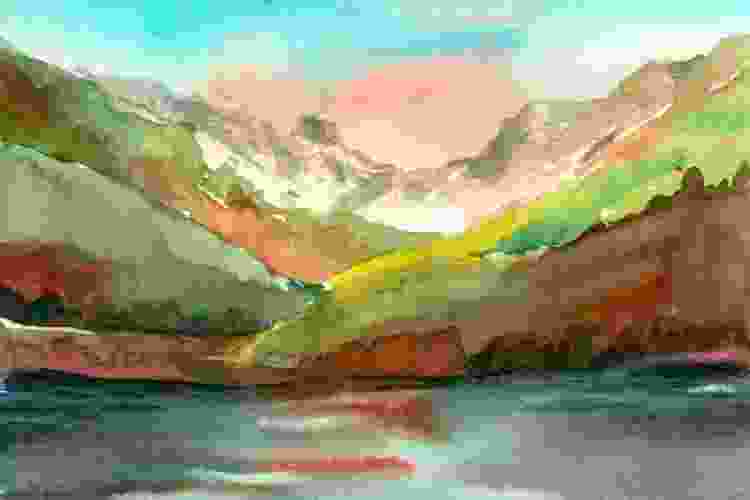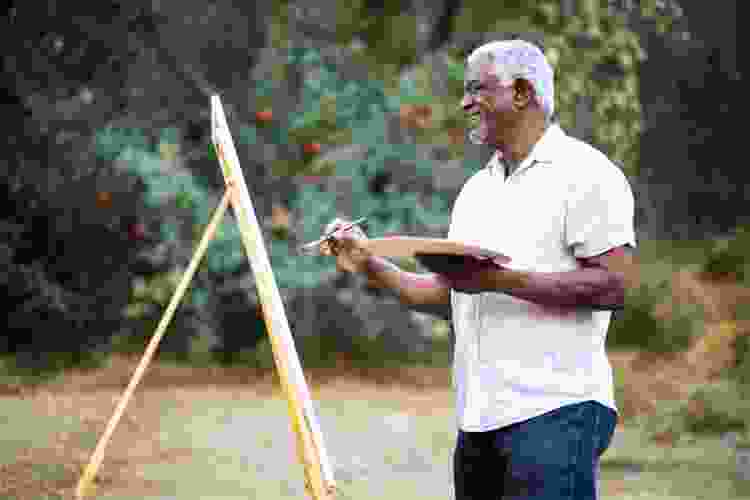23 Best Tips for Painting a Stunning Landscape in 2025

Painting a landscape has never been easier with our tips for beginners! So, how do you paint landscape scenery? We'll discuss working with the most popular paint mediums of oil, watercolor and acrylic.
According to Khamidovich, et. al. in their article for the Journal of Critical Reviews, painting landscapes is integral to human expression, where “In a landscape work, a person sings about his personality, intellect, inner feelings through images and creates an image of nature.”
So, you want to learn how to paint landscapes for beginners step by step? Follow these tips to create the gorgeous imagery of your dreams and the world around you.
Jump to Section
- Learn From Experienced Artists
- Painting a Landscape With Acrylics
- Painting a Landscape With Watercolors
- Painting a Landscape With Oil Paint
Learn From Experienced Artists
1. Join a Local Art Class
What are the basic rules for painting a landscape? World-class hosts are waiting to teach you the best methods and new skills to create gorgeous landscapes.
Look for art classes in Los Angeles, art classes in NYC, art classes in Chicago or art classes near you. You'll be amazed at how much fun and useful it can be to take instruction from skilled artists.

2. Try Paint and Sip
Dip your brush into lovely colors while you sip on your favorite adult beverage as you learn how to paint a landscape on canvas. That is the beauty of paint and sip — you can get a little tipsy and still make a beautiful piece of art!
Try paint and sip in Atlanta, paint and sip in Portland, paint and sip in Boston or paint and sip near you. Enjoy a night out with your friends and further your painting skills while you're at it.
3. Join Online Painting Classes
If leaving your house doesn't sound like your preferred method for learning how to paint a landscape on canvas (after all, you're looking for advice on the internet), then how about online painting classes?
You'll get the full instruction experience without having to get off your own very comfy couch — and you get to choose the snacks.
4. Get Back to Geometry
By turning trees, shrubs, mountains, clouds or any other such distinguished shapes in the scenery into geometric shapes like rectangles and ovals with your pencil, you'll give yourself a guide for your painting and the placement of each will turn out more accurate to the space than if you tried to recreate each individual detail.
When painting a landscape, directing lines is a technique professional artists use to guide the viewer's eyes to the landscape in the distance, such as including shapes and objects like fences or logs angled towards the background of the painting.
Bonus Tip: Palette knives are useful more than just for mixing colors. If you've ever watched an episode with professional artist Bob Ross, you know that palette knives can be used to add texture-like edges and defined lines to your artwork.
5. Study Color Theory
Value distribution involves distinguishing parts of the painting (the sky, grass, distant mountain range, etc.) by the hues and shades of the colors you use there — or by the color temperature.
The temperature is a spectrum from cool colors like blue and green to warm colors of yellows and reds. If you mix a little of a warm color into an area that is mostly cool, it makes it a little warmer and the opposite works with mixing cool colors into a warm area.
This is another way of changing the value distribution when painting a landscape, rather than the simpler version of mixing white to make a lighter hue or black to make a darker hue.
It can also be a creative way to give grass the amber glow of an autumn afternoon or turn the horizon into twilight instead of midnight or broad daylight.

Painting a Landscape With Acrylics
6. Apply a Base Layer
Painting the canvas a base color, such as yellow, before you begin the landscape itself, helps to give the work a unified tone. You can also use a primer-like product called Gesso.
If someone holds it up to the light, it will have a nice glow of that single color, rather than appearing paper-thin. It's the same principle as coating your walls or nails with a primer before adding your color of choice.
7. Shading
Value distribution can be useful for painting a landscape with shaded areas or objects halfway in shadow. Start by outlining the shape of the shadow cast by taller objects and paint them a dark or middle value (hue) of gray — or gray mixed with the color of the ground (eg. green for grass).
Then do the same with the areas of the painting in the light, but with lighter hues. This will show a definition between areas in the shade and areas in the light.
For objects half in the shadow and half in the light, you can use color pairs — two colors that look well opposite each other, which is how to paint depth with acrylics.
8. Four-Value Studies
Before painting your landscape, try to recreate the image with a four-value study, which is a smaller version done simply with black, white and a variety of gray hues.
This will help develop your sense of space division and guide you toward the way you want to use value distribution in your final version.
9. Background Before Foreground
Wondering how to paint a landscape with acrylics? It will make your art ideas come more easily if you start your acrylic landscape by painting the background first, then the larger aspects of the painting, and end with the minute details.

10. Damp Paper Towels
Damp paper towels are good for a lot of things! You can use them to clean a mistake from the canvas before the paint dries or to soften the lines on your acrylic landscape.
11. Paint Layers
When painting a landscape, it is important with acrylics to do a few coats to get the colors to truly pop out, especially if you're using some of the more cost-effective painting sets.
Without multiple paint layers, the results may be a bit thin and the colors won't appear as vibrant as you may have hoped.
Painting a Landscape With Watercolors
12. Paint From Light to Dark
As part of value distribution, particularly for painting a landscape with watercolors, it is most helpful to start by painting the lightest color features (white clouds, etc.) first.
Then gradually move to shaded objects and then to the darkest objects like trees and mountains. This method wouldn't work as well with oil or acrylics.
13. Keep Extra Water on Hand
Make sure you have two separate water containers when painting a landscape with watercolors — one to clean your brush between paint colors and another to add water to your painting to pull the colors across the page effectively.

14. Numerous Distant Details
By using value distribution and distinct colors for distinct foreground objects, like flowers and trees, you can also give the illusion of these same objects in the distance without painting individual details by using the same colors with more sweeping brushstrokes.
15. Tape It Down
Before you start painting your landscape, tape down your paper to keep it from stretching or buckling while you work, as it could cause the water to pool in places you don't want color concentration and other similar issues.
16. Add Contrast
Once your background is dry, add more of the same details to give the background more depth. Layer more paint on the important details to make them more vibrant.
To improve your color contrast, use a complex color palette. Mix your own colors or choose from the variety available on the market. Experiment with as many colors as you like — experimenting is essential when learning how to paint a landscape with watercolors or any medium.
17. Go Abstract
For landscape watercolor painting ideas for beginners, it is easy to create the idea of a mountain or trees on a hill without the details that make it specifically recognizable. Play with the concept of form in this delightful medium.
This is possible especially if you're doing a wet-on-wet painting (where you paint your details on top of the background while it is still wet).

Painting a Landscape With Oil Paint
18. Start Small
The more space you have to work with, the more overwhelmed you may feel. If you choose a smaller canvas, you'll have a more concise first project.
19. Change Up Your Brushstrokes
If you want to know how to start oil painting, know that it's easy to change the direction and duration of your brushstrokes. Diversify your brushstrokes by changing the length, width, thickness and shape of your strokes.
You can do this by using different parts of one brush, changing brush sizes or by using different types of brushes like filberts, which are wide and flat, or riggers, which are thin and cylindrical, to name a few.
20. Take a Photo
It may be helpful to paint from a photograph of the scene that you want to recreate, rather than from memory. With landscape photography, the details will be more accurate.
If you're wondering how to paint a landscape from a photo, it's about the same as painting from direct sight either paint what you see or sketch what you see first to get the dimensions accurate.
21. Painting in Plein Air
One of the most treasured methods for painting a landscape is to situate yourself in a scenic location outdoors and paint what's in front of you.
You can do this all in one sitting, or do the majority on location, and then finish the finer details back home (or in your studio). It's also one of the most inspirational ways to paint!

22. Imperfection is Beautiful
Take it from the Impressionists, when painting a landscape, it doesn't have to be perfect. Imperfection is natural and therefore beautiful. You'll also find yourself less stressed if you can embrace the mysteries of life — call it "taking artistic liberties" or "creative license."
23. Indirect Color Mixing
By layering one color over another thinly, your brain can pick up the underlying color as well and will translate the two colors to something in between.
This gives your painting a different vibrancy and texture than if you simply mixed the two colors before spreading them on the canvas.
What are the four parts of a landscape painting? The type of paint and brushes you're using is a good start, as well as your color palette and the scene you're hoping to recreate — whether it's in your direct vision, in your memory or in a photograph.
These are excellent painting tips for beginners, but there are plenty more painting techniques out there if you're looking to learn tips for painting landscapes or other art forms.
For even more fun art ideas, check out other experiences happening on Classpop!

